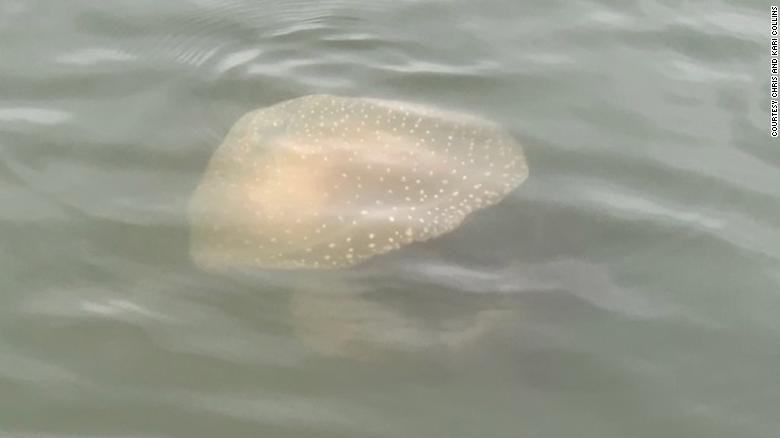Wildlife officials in South Carolina are asking boaters to keep their eyes peeled for an invasive species of jellyfish that can grow to beach ball size and are big enough to damage boats and fishing equipment.
The South Carolina Department of Natural Resources says that it got a report last week of a huge jellyfish in Murrells Inlet, about 25 miles south of Myrtle Beach.
Chris Collins told CNN that he and his wife Kari were enjoying an evening cruise in their boat on October 28 when they saw the jellyfish in a creek that is a good distance away from the ocean.
“When we first saw it, I thought it was maybe a sea turtle or a large sting ray, so we turned around to get a better look,” Collins said. “Once we saw it was a jellyfish that we were not familiar with, we wanted to get some pictures to share to see if anyone could help identify it.”
The couple had never seen a jellyfish like that, so they posted the pictures on Facebook and then sent them to the SCDNR for identification.
Staff members identified it as an Australian spotted jellyfish, spokeswoman Erin Weeks told CNN.
She said they can be a danger to fishing gear and boats because of their size and the volume of jellyfish that occur in blooms. They can get stuck in boats’ water intake lines and put a strain on fishing nets when they get scooped up.
The agency shared the Collins’ photos of the jellyfish on Facebook and said that they can “form large ‘blooms’ that gobble up fish and shellfish eggs and damage boats and fishing gear.”
Australian spotted jellyfish are native to the tropical western Pacific Ocean and typically grow to more than 17-inches in diameter (about the size of a large pizza) but can reach up to two feet in diameter, according to the US Geological Survey’s Nonindigenous Aquatic Species database.
NAS program director Wesley M. Daniel told CNN that he couldn’t tell how big this jellyfish was because there’s nothing in the photo to compare it to.
There have been reports of a half dozen Australian spotted jellyfish in South Carolina in the last two weeks, and it’s very likely that there are a lot more in the area, Daniel said.
“The majority of sightings are individual jellyfish that have washed up onshore,” Daniel said. “An established Australian spotted jellyfish population occurs in waters east of the Mississippi River in the northern Gulf of Mexico. We do not know the status of the South Carolina population at this moment.”
They’ve been spotted in the Gulf of Mexico and along the Atlantic coast from Florida to North Carolina, according to the NAS.
Weeks said this is the first time this species has been seen in Murrells Inlet, but it has been reported in South Carolina waters before — including a 2017 bloom that was confirmed in Port Royal Sound, near Hilton Head.
“The Australian spotted jellyfish is believed to have been introduced globally through shipping traffic (it undergoes a polyp stage that can attach to vessel hulls, gas platforms, etc.),” Weeks said in an email.
Weeks said the Australian spotted jellyfish’s sting ranges from mild to unnoticeable, but he said getting them out of a fishing net can be challenging.
>>>>


